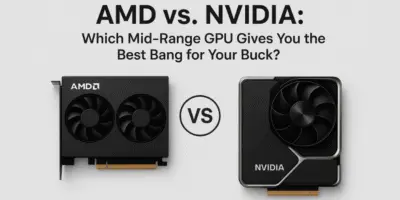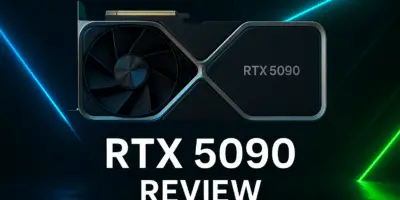What you’re looking at is likely the most affordable card I can recommend from Nvidia right now. But pay close attention to what I’m saying—this is a new launch, and honestly, I’m getting tired of all these releases. As content creators, we need a break! But wait, the journey doesn’t start here. Let’s take a step back to understand the bigger picture.
Table of Contents
- The Evolution of Nvidia’s 60-Series
- A Ray of Hope: Price Drop
- The Gigabyte Gaming OC Model
- Thermals and Power Consumption
- The Critical VRAM Upgrade
- Testing Setup and Initial Comparisons
- New Encoders Make a Difference
- The 16GB VRAM Advantage in Real-World Use
- The Logical Comparison: RTX 4060 Ti vs. RTX 5060 Ti
- Content Creation Performance
- Frame Generation and Latency
- Conclusion: Is It Worth It?
The Evolution of Nvidia’s 60-Series
Most of you watching probably remember the GTX 1060, which has been Nvidia’s best-selling card globally and the one most people care about. When the 1060 launched, it came in 3GB and 6GB variants. Back then, all of us were convinced that Nvidia was lagging behind—AMD had the RX 580 with 4GB and 8GB of VRAM.
Later, Nvidia released the RTX 2060 with 6GB of VRAM, but we were impressed with its performance and the new RTX features. They followed up with the RTX 2060 Super with 8GB—nice move, Nvidia was heading in the right direction.
Then came the RTX 3060 with a whopping 12GB of VRAM. What we didn’t realize was that this wasn’t just Nvidia being generous; it was actually due to technical constraints with the GPU, which could only interface with either 6GB or 12GB of memory. So Nvidia went with 12GB.
You might ask, “But what about the later RTX 3060 8GB version?” Well, that GPU had some differences, resulting in lower performance, which confirms that the 12GB was probably a mistake in the first place.
Moving to the 40-series, the RTX 4060 had 8GB of VRAM, and the RTX 4060 Ti also had 8GB. If you wanted 16GB, you had to pay more.
Now we’re at the RTX 5000 series: the RTX 5060 has 8GB of VRAM, the RTX 5060 Ti has 8GB, and if you want more memory, there’s the RTX 5060 Ti with 16GB. If you want to see more videos and reviews, check out Epic Hardware—no need to pay extra, just like, subscribe, and hit the notification bell!
A Ray of Hope: Price Drop
There’s a small ray of hope, though—the MSRP of the RTX 5060 Ti is $70 less than the RTX 4060 Ti. This might be the only silver lining here.
The Gigabyte Gaming OC Model
Let’s dive into the actual card. The model I have is the Gigabyte Gaming OC RTX 5060 Ti with three fans. Despite having three fans, it’s not big at all—it’s quite compact and only takes up two PCIe slots. Fun fact: most of the card’s length is actually the cooling system; the actual PCB ends much earlier.
The card comes with the standard 8-pin power connector. Of course, there are higher-end versions available from Gigabyte and other manufacturers.
Thermals and Power Consumption
I ran the card through Furmark at 4K for 15 minutes, and the temperature peaked at 62°C. That’s impressive for the Gigabyte Gaming OC three-fan model, which isn’t even their top-tier offering (they have higher-end AORUS models). Three fans keeping it at just 62°C at 4K is fantastic!
I imagine that even the more basic two-fan Gigabyte model would handle temperatures just fine, given how cool this one runs.
As for power consumption, this card with its 8-pin connector now draws 180 watts, up from 160 watts in the previous generation.
The Critical VRAM Upgrade
Perhaps the most important change in this card is the VRAM. It now has 16GB of GDDR7 memory, compared to 16GB of GDDR6 in the previous generation. Everything else remains largely the same—it’s still a 128-bit memory interface (which I wasn’t happy with in the previous generation and still am not), and the CUDA core count has only seen a modest increase to 5,256 cores. It’s also manufactured using the same process node.
Testing Setup and Initial Comparisons
When I first got the card, I was excited to test it with the Ultra 9 285K processor, the AORUS Master motherboard, and a nice RAM kit. My first comparison was against the RTX 4070 Ti, which I initially thought might be overkill, but let’s see the benchmark results.
When I saw the actual performance numbers, I realized there was a significant gap: 140 FPS vs. 193 FPS, 125 FPS vs. 167 FPS, 67 FPS vs. 40 FPS to 50 FPS. Clearly, these cards are in different tiers entirely.
New Encoders Make a Difference
One important thing I wanted to confirm: the RTX 5060 Ti comes with Nvidia’s new encoders, while the RTX 4070 Ti uses the older ones. The new encoders offer better and stronger support, especially for 10-bit content.
I rendered a 10-bit video on both cards, and interestingly, the RTX 5060 Ti finished rendering seven seconds faster. You might think, “Why are you excited about just seven seconds?” Well, the point is that the RTX 4070 Ti is actually a slightly more powerful card than the RTX 5060 Ti, yet the new card finished faster. This proves my theory from the RTX 5080 review that the new encoders are a critical advantage for content creators.
The 16GB VRAM Advantage in Real-World Use
Remember that video where I pushed the Mac Mini M4 to its limits? I rendered that same video on both cards, with fascinating results. The RTX 5060 Ti completed the render in 33.5 minutes, while the RTX 5080 did it in around 27 minutes. The RTX 4070 Ti, however, couldn’t render the video at all—it kept throwing errors.
You might wonder if there was something wrong with the 4070 Ti, but that wasn’t the case. Half of this video was shot on a Cinema S Look 3 camera, and the rest on my camera, all at high bit rates, in RAW format, with many layers and motion effects in After Effects. I’ve tried rendering this video on many cards, and any card with less than 16GB of VRAM fails.
This is practical evidence for why 16GB of VRAM should be your standard, even if you don’t think you need it right now. Your work might evolve in the future and require it.
However, the performance gain of the RTX 5060 Ti over the RTX 4070 Ti isn’t consistent across all applications. For example, in Blender, the RTX 4070 Ti completely outperforms the RTX 5060 Ti. The performance advantage depends entirely on the software you’re using.
The Logical Comparison: RTX 4060 Ti vs. RTX 5060 Ti
Let’s get to the sensible comparison: the RTX 4060 Ti versus the RTX 5060 Ti, tested with our Ultra 9 processor.
Starting with Shadow of the Tomb Raider, we see an average increase of about 22% at 1080p with RTX and DLSS turned off. When we enable these features, the difference narrows to about 13% because the technologies themselves make a difference.
Testing F1 2022 with all enhancements turned off, we see a difference of about 22% again. With enhancements enabled, the difference remains strong at about 25%.
Moving to Nvidia’s darling, Cyberpunk 2077, with RTX, DLSS, and all enhancements turned off, we again see a performance improvement of over 20%. Enabling RTX, DLSS, and Frame Generation (using the 2x mode that works on both the 4060 Ti and 5060 Ti), we still see an impressive improvement percentage.
Red Dead Redemption 2 maintains the same pattern with performance increases above 20%. For more CPU-bound games like League of Legends, the new card still manages a respectable 15% boost, which is impressive considering these games rely more on the processor than the graphics card.
Rainbow Six Siege, another CPU-bound game, shows the RTX 5060 Ti delivering 443 FPS versus 387 FPS on the 4060 Ti—about a 13.5% improvement despite the CPU dependency.
Content Creation Performance
For creative workloads, V-Ray (both on CUDA and RTX modes) shows significant improvements of up to 30% or more. In Adobe Premiere Pro, the new 5060 Ti reduces render times by about 28% compared to the 4060 Ti.
However, this performance boost isn’t consistent across all applications. In Blender, for instance, the advantage is only about 10-15%.
Frame Generation and Latency
Testing Frame Generation has become essential in modern GPU reviews. In Alan Wake 2 at 1440p with 2x Frame Generation, we achieved 77 FPS, but with 4x Frame Generation, this jumped to about 134 FPS.
Similarly, in Cyberpunk 2077 at 1440p with RTX on Ultra and Frame Generation, we went from 109 FPS (2x) to an average of 186 FPS (4x)—an impressive number.
Star Wars showed similar scaling, going from 77 FPS (2x) to 128 FPS (4x) at 1440p.
Regarding latency when using Multi-Frame Generation at 1080p, you won’t have any issues—latency typically stays within 30-35ms if you’re playing story modes, and around 20ms or less for sports games. Even at 1440p in games with Nvidia Reflex enabled, like Marvel Rivals, we were breaking 300 FPS on Ultra settings with a total system latency of around 17-18ms, which is excellent.
Conclusion: Is It Worth It?
After all these tests, I can say that the new RTX 5060 Ti outperforms the previous generation RTX 4060 Ti by an average of 20.1%—let’s just call it 20%. But is this 20% enough for the RTX 5060 Ti to match the RTX 4070? Unfortunately, no. Even the standard RTX 4070 is still about 10-15% more powerful than the RTX 5060 Ti.
The MSRP for the 16GB version of this card starts at around $429, while the 8GB version starts at $379. If it becomes available in Egypt, it would likely cost around 25,000-27,000 EGP ($500-540), making it about 5,000 EGP ($100) cheaper than the RTX 4070, which costs around 33,000 EGP ($660).
Given that it’s 10-15% less powerful but has more VRAM and costs less, I wouldn’t call it the “deal of the century,” but it’s not bad either. It delivers the expected generational improvement.
One important piece of advice: don’t buy the 8GB VRAM version. Yes, there’s a $50 difference, but 8GB of VRAM is no longer sufficient, even at 1440p, and will be even less adequate in the future at 1080p. For professional work, 8GB is completely inadequate.
That’s why I’ve titled this review “The Most Affordable Worthwhile Card from Nvidia”—because cheaper options like the RTX 5060 Ti 8GB or the standard RTX 5060 with 8GB simply aren’t worth investing in, despite all the new technologies.
You might ask, “If this card costs around $430 (25,000-27,000 EGP after taxes), why not just buy the RTX 4070?” Here’s the key difference: the RTX 4070 and RTX 4070 Super have 12GB of VRAM, while this card has 16GB. For people prioritizing higher VRAM, this is the most affordable respectable option with 16GB. The next card up with 16GB would be the RTX 4070 Ti Super, which costs at least 38,000-39,000 EGP ($760-780), making it 10,000-11,000 EGP ($200-220) more expensive than the RTX 5060 Ti.
Yes, the 4070 Ti Super is definitely more powerful, but that’s still a significant price difference.


